Related Research Articles
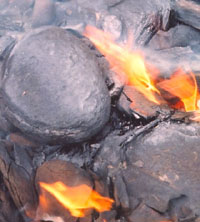
Oil shale is an organic-rich fine-grained sedimentary rock containing kerogen from which liquid hydrocarbons can be produced. In addition to kerogen, general composition of oil shales constitutes inorganic substance and bitumens. Based on their deposition environment, oil shales are classified as marine, lacustrine and terrestrial oil shales. Oil shales differ from oil-bearing shales, shale deposits that contain petroleum that is sometimes produced from drilled wells. Examples of oil-bearing shales are the Bakken Formation, Pierre Shale, Niobrara Formation, and Eagle Ford Formation. Accordingly, shale oil produced from oil shale should not be confused with tight oil, which is also frequently called shale oil.
Unconventional oil is petroleum produced or extracted using techniques other than the conventional method. Industry and governments across the globe are investing in unconventional oil sources due to the increasing scarcity of conventional oil reserves. Unconventional oil and gas have already made a dent in international energy linkages by reducing US energy import dependency.
Shale oil is an unconventional oil produced from oil shale rock fragments by pyrolysis, hydrogenation, or thermal dissolution. These processes convert the organic matter within the rock (kerogen) into synthetic oil and gas. The resulting oil can be used immediately as a fuel or upgraded to meet refinery feedstock specifications by adding hydrogen and removing impurities such as sulfur and nitrogen. The refined products can be used for the same purposes as those derived from crude oil.
Viru Keemia Grupp (VKG) is an Estonian holding group of oil shale industry, power generation, and public utility companies.
Petrosix is the world's largest surface oil shale pyrolysis retort with an 11 metres (36 ft) diameter vertical shaft kiln, operational since 1992. It is located in São Mateus do Sul, Brazil, and it is owned and operated by the Brazil energy company Petrobras. Petrosix means also the Petrosix process, an externally generated hot gas technology of shale oil extraction. The technology is tailored to Irati oil shale formation, a Permian formation of the Paraná Basin.
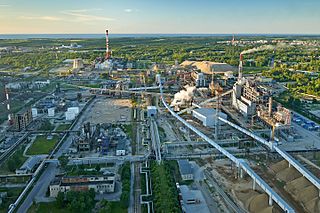
The oil shale industry is an industry of mining and processing of oil shale—a fine-grained sedimentary rock, containing significant amounts of kerogen, from which liquid hydrocarbons can be manufactured. The industry has developed in Brazil, China, Estonia and to some extent in Germany and Russia. Several other countries are currently conducting research on their oil shale reserves and production methods to improve efficiency and recovery. Estonia accounted for about 70% of the world's oil shale production in a study published in 2005.

Shale oil extraction is an industrial process for unconventional oil production. This process converts kerogen in oil shale into shale oil by pyrolysis, hydrogenation, or thermal dissolution. The resultant shale oil is used as fuel oil or upgraded to meet refinery feedstock specifications by adding hydrogen and removing sulfur and nitrogen impurities.
Oil shale economics deals with the economic feasibility of oil shale extraction and processing. Although usually oil shale economics is understood as shale oil extraction economics, the wider approach evaluates usage of oil shale as whole, including for the oil-shale-fired power generation and production of by-products during retorting or shale oil upgrading processes.

Environmental impact of the oil shale industry includes the consideration of issues such as land use, waste management, and water and air pollution caused by the extraction and processing of oil shale. Surface mining of oil shale deposits causes the usual environmental impacts of open-pit mining. In addition, the combustion and thermal processing generate waste material, which must be disposed of, and harmful atmospheric emissions, including carbon dioxide, a major greenhouse gas. Experimental in-situ conversion processes and carbon capture and storage technologies may reduce some of these concerns in future, but may raise others, such as the pollution of groundwater.

The history of the oil shale industry started in ancient times. The modern industrial use of oil shale for oil extraction dates to the mid-19th century and started growing just before World War I because of the mass production of automobiles and trucks and the supposed shortage of gasoline for transportation needs. Between the World Wars oil shale projects were begun in several countries.
Oil shale gas is a synthetic non-condensable gas mixture (syngas) produced by oil shale thermal processing (pyrolysis). Although often referred to as shale gas, it differs from the natural gas produced from shale, which is also known as shale gas.
Oil shale in China is an important source of unconventional oil. A total Chinese oil shale resource amounts of 720 billion tonnes, located in 80 deposits of 47 oil shale basins. This is equal to 48 billion tonnes of shale oil. At the same time there are speculations that the actual resource may even exceed the oil shale resource of the United States.
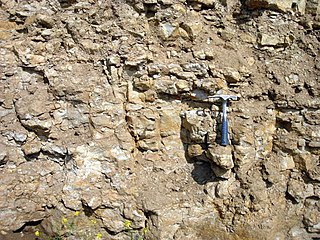
There are two kinds of oil shale in Estonia, both of which are sedimentary rocks laid down during the Ordovician geologic period. Graptolitic argillite is the larger oil shale resource, but, because its organic matter content is relatively low, it is not used industrially. The other is kukersite, which has been mined for more than a hundred years. Kukersite deposits in Estonia account for 1% of global oil shale deposits.

Narva Oil Plant is a commercial scale shale oil retorting facility located in Auvere near Narva, Estonia. The plant produces shale oil from oil shale by using Galoter/Eneffit technology. The facility belongs to Enefit Energiatootmine, a subsidiary of Eesti Energia.
The TOSCO II process is an above ground retorting technology for shale oil extraction, which uses fine particles of oil shale that are heated in a rotating kiln. The particularity of this process is that it use hot ceramic balls for the heat transfer between the retort and a heater. The process was tested in a 40 tonnes per hour test facility near Parachute, Colorado.
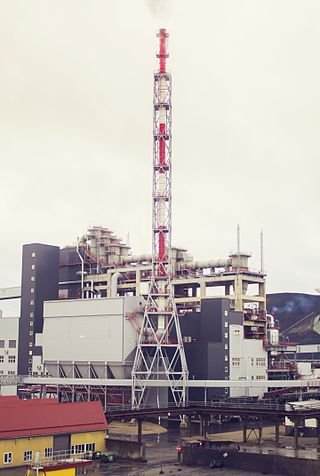
The Galoter process is a shale oil extraction technology for a production of shale oil, a type of synthetic crude oil. In this process, the oil shale is decomposed into shale oil, oil shale gas, and spent residue. A decomposition is caused by mixing raw oil shale with a hot oil shale ash, generated by combustion of carbonaceous residue (semi-coke) in the spent residue. The process was developed in 1950s and it is used commercially for the shale oil production in Estonia. There are projects for further development of this technology and for expansion of its usage, e.g. in Jordan and USA.
The Alberta Taciuk process is an above-ground dry thermal retorting technology for extracting oil from oil sands, oil shale and other organics-bearing materials, including oil contaminated soils, sludges and wastes. The technology is named after its inventor William Taciuk and the Alberta Oil Sands Technology and Research Authority.
The Fushun process is an above-ground retorting technology for shale oil extraction. It is named after the main production site of Fushun, Liaoning province in northeastern China.
The Hytort process is an above-ground shale oil extraction process developed by the Institute of Gas Technology. It is classified as a reactive fluid process, which produces shale oil by hydrogenation.
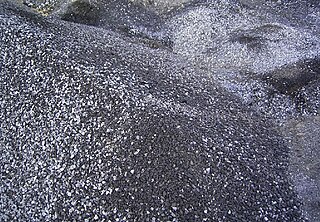
Spent shale or spent oil shale is a solid residue from the shale oil extraction process of producing synthetic shale oil from oil shale. It consists of inorganic compounds (minerals) and remaining organic matter known as char—a carbonaceous residue formed from kerogen. Depending on the extraction process and the amount of remaining organic matter, spent shale may be classified as oil shale coke, semi-coke or coke-ash residue, known also as oil shale ash. According to the European Union waste list all these types of spent shale are classified as hazardous waste.
References
- 1 2 Väli, E.; Valgma, I.; Reinsalu, E. (2008). "Usage of Estonian oil shale" (PDF). Oil Shale. A Scientific-Technical Journal. Estonian Academy Publishers. 25 (2): 101–114. doi:10.3176/oil.2008.2S.02. ISSN 0208-189X . Retrieved 2008-11-23.
- 1 2 3 Koel, Mihkel (1999). "Estonian oil shale". Oil Shale. A Scientific-Technical Journal. Estonian Academy Publishers (Extra). ISSN 0208-189X . Retrieved 2008-11-23.
- ↑ Kattai, V.; Lokk, U. (1998-02-17). "Historical review of the kukersite". Geological Survey of Estonia. Archived from the original on 2017-03-24. Retrieved 2008-11-23.
- ↑ Uustalu, Jaan (2000). "Utilization of semi-coke for energy production". In Rofer, Cheryl K.; Kaasik, Tõnis (eds.). Turning a Problem Into a Resource: Remediation and Waste Management at the Sillamae Site, Estonia. Axel Springer AG. p. 223. ISBN 978-0-7923-6186-2 . Retrieved 2008-11-23.
- ↑ Survey of energy resources (PDF) (edition 21 ed.). World Energy Council (WEC). 2007. pp. 93–115. ISBN 978-0-946121-26-7. Archived from the original (PDF) on 2011-04-09. Retrieved 2008-11-23.
- ↑ Leveinen, Jussi; Aneshkin, Boris; Blanchard, Francois; Staudt, Michael; Van den Dool, Gijs; Sapon, Svetlana; Kruglova, Olga (16–20 September 2007). Modelling impacts of oil-shale mining on groundwater resources in the Slantsy region, Russia. 15th Meeting of the Association of European Geological Societies. Tallinn, Estonia. Archived from the original (PPT) on 2016-03-04. Retrieved 2017-05-07.
- ↑ Burnham, Alan K.; McConaghy, James R. (2006-10-16). "Comparison of the acceptability of various oil shale processes" (PDF). Golden: 26th Oil shale symposium. UCRL-CONF-226717. Archived from the original (PDF) on 2016-02-13. Retrieved 2008-11-23.
- 1 2 Jaber, Jamel O.; Sladek, Thomas A.; Mernitz, Scott; Tarawneh, T. M. (2008). "Future Policies and Strategies for Oil Shale Development in Jordan" (PDF). Jordan Journal of Mechanical and Industrial Engineering. 2 (1): 31–44. ISSN 1995-6665 . Retrieved 2008-11-22.
- ↑ Mölder, Leevi (2004). "Estonian Oil Shale Retorting Industry at a Crossroads" (PDF). Oil Shale. A Scientific-Technical Journal. Estonian Academy Publishers. 21 (2): 97–98. doi:10.3176/oil.2004.2.01. ISSN 0208-189X. S2CID 252707682 . Retrieved 2008-11-23.
- ↑ Soone, Jüri; Riisalu, Hella; Kekisheva, Ljudmilla; Doilov, Svjatoslav (2006-11-07). Environmentally sustainable use of energy and chemical potential of oil shale (PDF). International Oil Shale Conference. Amman, Jordan: Jordanian Natural Resources Authority. pp. 2–3. Archived from the original (PDF) on 2007-09-28. Retrieved 2007-06-29.
- ↑ "Strategic significance of America's oil shale resource. Volume II: Oil shale resources, technology and economics" (PDF). Office of Deputy Assistant Secretary for Petroleum Reserves; Office of Naval Petroleum and Oil Shale Reserves; United States Department of Energy. 2004. Retrieved 2008-11-23.
- ↑ "An Assessment of Oil Shale Technologies" (PDF). June 1980. NTIS order #PB80-210115. Retrieved 2008-11-23.